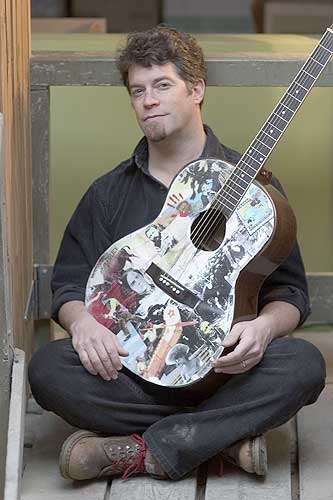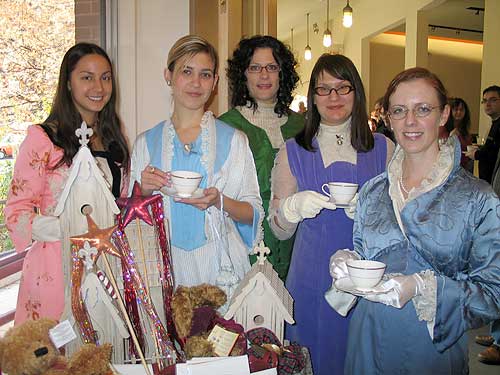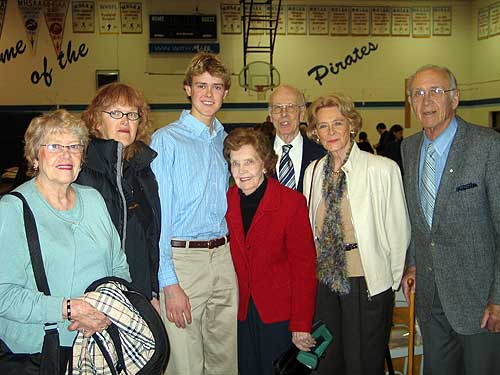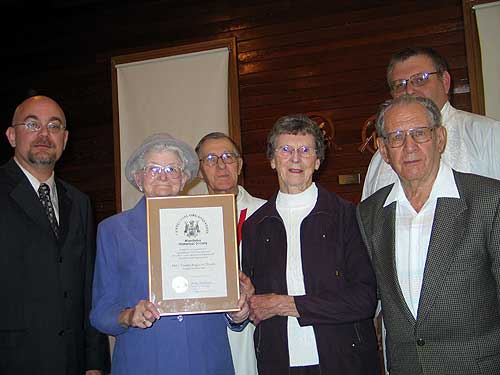President's Message - The Inaccessible Information Age
MHS Young Historians Awards 2005
Centennial Organization Presentation
Furniture Research Makes Promising Gains
The 41st Annual Sir John A. Macdonald Dinner will be held on Saturday, 14 January 2006 at the historic Fort Garry Hotel, beginning with a reception at 6:00 PM with dinner to follow at 7:00 PM. We cordially invite you to support this important fundraising event, bring your friends, and have a fun evening of history and entertainment.

Mike Ford
Rather than having a speaker, the highlight of this year's dinner will be Mike Ford, formerly of the band Moxy Früvous, known for the humorous songs and witty banter of its members. Mike is now touring schools throughout Canada performing original music with themes drawn from Canadian history. His new CD, Canada Needs You, Volume 1 includes several songs on Manitoba's history. Mike's music, combined with his infectious enthusiasm and great showmanship, will make this a truly memorable evening.
The evening will also include presentations of our Centennial Business Awards to Manitoba firms which have operated continuously for 100 years or more, and a Silent Auction of great items for sale. Ron Robinson of CBC Radio 1 will be the MC.
I have written in previous columns about the great opportunities that the Internet represents to societies such as ours. Putting information about the history of Manitoba on our web site (www.mhs.mb.ca) provides at least five advantages: 1) it is always available, regardless when one wants to examine it; 2) it is available globally, wherever there is Internet access; 3) it is more easily searched for specific words or phrases than any paper-based equivalent; 4) it can be updated to correct errors and provide more detail; and 5) it makes following cross-references between related bits of information fast and easy. I am a big fan of the Internet and I believe that, some day, most of us will use it for all routine correspondence. (Yes, I believe the days of the handwritten letter are virtually over!) We are witnessing the convergence of traditional media – radio, television, and newspapers – into one medium in the Internet. Already, nearly all newspapers are reporting marked decreases in their circulation, some as dramatic as 10% over the last year as readers – especially young, technologically-savvy ones – get more of their news from email, web sites, and blogs (short for “web logs”). This trend, while inevitable, does have several very distinct downsides. For one, we are becoming conditioned to think of the Internet as our primary information source, leading us to neglect the fact that an enormous amount of information remains on paper, microfilm, and other “offline” places. Already, I find that many University students search for information exclusively on the Internet and, finding nothing on a particular subject, conclude that nothing exists when, in fact, there are extensive resources on library shelves. This trend is especially worrisome for historical research, where it is likely that most of the important primary sources of information will remain offline for the foreseeable future. Sure, there are digitization projects – including our own web site – aimed at putting paper-based documents online. But they can never hope to put more than a small percentage of the total available content there. Genealogists are grumbling that the availability of birth, marriage, and death information on such web sites as genealogy.com, familysearch.org and others is causing people to neglect the resources in local, regional, and national archives. Usually, the online information is only the “tip of the iceberg”. For example, Library and Archives Canada has scanned the attestation papers for nearly all men and women who served in the First World War, and has put them on their web site. The two pages of each attestation record provides such basic information as a person’s next-of-kin, birth date, occupation, religion, height, and eye and hair color. But, having viewed the files from which the attestation papers were taken, I can vouch for the richness of the data in them: a full service record including commendations, assignments, punishments (if warranted), and medical history. Online records are great, but we must be mindful that comprehensive historical research will continue to depend on access to records which will never be available on the Internet.
A second worrisome aspect of the move to digital, online media is that we are storing huge amounts of information in a format which, while readily accessible now, will quickly become inaccessible. We are living in what is sometimes called “The Information Age” yet it is ironic that this time might end up being the most poorly documented period in the last couple of centuries. Whereas historians of the 20th century have access to text documents and imagery for a rich characterization of day-to-day life, historians of the 22nd century will be faced with magnetic and optical disks (floppies, tapes, cartridges, CDs, DVDs, flash drives, etc.) whose longevity is far shorter than good old paper. No one is quite sure how long these media last, and it may only be a decade or two. Even if the media themselves remain viable, the hardware needed to read them may be unavailable. My doctoral thesis, for example, is contained on a large magnetic tape that I keep purely for sentimental reasons: the University has long ago discarded the machine needed to read it. (Having learned this lesson, I now keep a graveyard of obsolete, but perfectly functional, computers in my garage to enable me to access old data files into the future.) And even if the media remain good and we retain hardware capable of accessing them, the formats in which the information is physically stored – often proprietary to the company which created it – may not be accessible if those companies go out of business or refuse to release those formats to the public domain. Some computer software, such as Microsoft Word, is capable of reading any file created by any version of the program going back to its humble origins. But the same cannot be said of all programs. Adobe Pagemaker, the software that the MHS uses to lay out its journal, Manitoba History, can only read the version just prior to the current one. This means that documents created in the early days of desktop publishing are now effectively inaccessible. I predict that companies which specialize in providing access to archaic digital storage media, computer hardware, and software will become increasingly numerous and prosperous in the years ahead.
The increasing ubiquity of electronic mail (and the diverse range of software used to send and receive it) means that future historians may not have access to the sort of information that present historians take for granted. We can easily read letters written to and by our early Prime Ministers – because the original paper copies are saved in the national archives – but we may not be able to read letters from our present and future PMs because they were sent via email. And what about backups? There is only limited ability to preserve the present contents of the Internet. (See www.archive.org where you can, for instance, see the MHS web site circa 1998.) Unlike traditional newspapers, which preserve a “paper trail” of misquotes, misspellings, and other miscellaneous errors, online newspapers can effectively “censor” their old information so no sign may remain that errors were ever made! Insight on the beliefs and practices of a culture is often gained by observing how it deals with its mistakes. What will happen when future historians look back at our online culture and find that it appears not to have made any? The bottom line, at least for me, is that the Internet is here to stay and we should embrace it for all its benefits. But we should remain aware of its limits and work to find solutions that will preserve our present for the benefit of descendants who may otherwise know nothing about us.
This is my last chance to remind you to buy tickets for the 2006 Macdonald Dinner. This is our single most important fundraiser of the year, and its proceeds help to support the range of services which MHS members enjoy. This year’s Dinner promises to be a great evening of mirth and music with performer Mike Ford in the magnificent setting of the Fort Garry Hotel. Join us, and bring along some friends – the more, the merrier! Contact the MHS office by mail or leave us a voice mail message at 204-947-0559 and we’ll set aside as many tickets as you need. MHS members can purchase a pair for $200, compared to the regular price of $110 each. Also remember that donations are gratefully received; they must be postmarked by 31 December so that receipts can be issued for the 2005 tax year. As always, I welcome your ideas and comments on anything relating to the MHS. Call me at 204-474-7469 or send email to president@mhs.mb.ca. In closing, I wish you and yours an enjoyable holiday and a prosperous new year!
Gordon Goldsborough
President, Manitoba Historical Society

Ladies dressed in period costume at the Dalnavert Visitors Centre on November 13 for the launch of Jim Blanchard's book, Winnipeg 1912. Left to right: Jacenta Bahri, Rachel Van Caeseele, Kimberly Middagh, Stephanie Middagh, and Judy Wakefield.
There has been a lot of activity at Dalnavert Museum recently. On November 13 a large crowd attended the launch of Jim Blanchard’s book in the Visitors Centre. On November 30, the museum took in a little over $1000 in a single day. This is the first time this has happened in the first six months of operation. This was from a combination of gift shop sales, admissions and ticket sales for events. There were two events on that day: a seniors’ lunch and the second in the Dalnavert Lecture Series. The Lecture attracted about 40 people many of whom bought items in the shop.. The entertaining and informative lecture, titled “Criminals, lunatics, and loose women: Always a swinging time at the Vaughan Street Jail”, was delivered by Kristen VerinTreusch of Muddy Water Tours. Kristen has done extensive research on the history of the jail, one of the oldest provincial buildings in the province, has led wildly popular tours through it during the Doors Open events in 2004 and 2005, and is a co-founder of the Friends of Vaughan Street Jail.
December is a special time to visit Dalnavert Museum. Dalnavert is festively decorated to celebrate a Victorian Christmas. Also, a magnificent Christmas display will catch your eye in the Visitor’s Centre and the Gift Shop is well stocked with a vast variety of gift items for Christmas shoppers.
On Sunday, December 4 2:00 pm Shilling Bear - The Story of a Victorian Teddy was presented in costume by Cindy Robin. “Shilling Bear” is the tale of a teddy that changes the lives of two families. The theme of the story is kindness and sharing; was perfect holiday fare for families and children of all ages. Admission was free, but seating is limited. Museum admission was half-price with the donation of a “tin for the bin” for Winnipeg Harvest. On Wednesday, December 7 7:30 pm a special program, “Tis the Season! Christmas and Hogmanay (New Year’s) Traditions” was presented by the School of Scottish Arts and Dalnavert Museum.
The Holiday Classic - Charles Dickens’ A Christmas Carol - will be presented on Monday, December 19 to Friday, December 23 at 7:30 pm. Experience the magic of a Christmas past as actor Richard Hurst brings this beloved tale to life. Savor the readings in the comfort of our new, fully accessible Visitors’ Centre and stay for light refreshments after the show. Doors will open at 6:15 so you can view the Museum decked out in all its Christmas finery and hear carols performed by the Potpourri Singers. Tickets $12.99 (plus GST). SOLD OUT.
Attend the next lecture in the Dalnavert Lecture Series on Wednesday January 25 at 7 pm. The topic is One House. Many Homes: Transition on Furby Street in Winnipeg, 1900 to 2000. Dr. Davis Burley of the University of Winnipeg will speak on his recent research in inner city Winnipeg. Please call the museum to reserve a spot. Seating is limited. The cost of only $5 per person includes light refreshments. Proceeds help to support ongoing programming at Dalnavert.
Edmund Grindlay Berry, a long-time MHS member, died on November 3 in Winnipeg at 90 years of age. He was born in Scotland and at the age of 12 immigrated to New Brunswick with his parents. He obtained his PhD in Classics from the University of Chicago in 1940. Dr. Berry was a Professor of Classics at the University of Manitoba from 1940 to 1980. He served as President of the Humanities Association of Canada and the Classical Association of Canada, and was Chair of the Humanities Research Council. He was elected a Fellow of the Royal Society of Canada in 1971. He and his wife Virginia who died in 2003 attended many MHS functions over the years.
This year’s Film Night, a joint presentation by the CBC, the Provincial Archives, the U of Winnipeg, and the MHS, was held on November 17 at the University of Winnipeg. The feature film “Winnipeg – Century One” was a selection of news clips put together for Winnipeg’s centennial in 1974. Film highlights included the capture of “Strangler” Nelson, the 1950 flood, the 1954 Times Building fire, and the 1966 March blizzard. Another film showed us some CBC Winnipeg productions from the mid-1950s and showed how they were made.
On 6 December 2005, Joan Pagan, led the discussion on the book by William Wallace, My Dear Maggie: Letters from a Western Manitoba Pioneer, edited by Kenneth S. Coates and William R. Morrison, Great Plains, 1991. Her own family plays a prominent role in these detailed letters from the 1880s documenting pioneer life in the Shell River area. Plans for the rest of the year include the following books:
24 January 2006 |
Discussion led by Shirlee Anne Smith, on Charlotte Gray’s Sisters in the Wilderness |
22 February 2006 |
We will attend the MHS program in which Dr. Stuart Houston is speaking on Eighteenth-Century Naturalists of Hudson Bay, McGill-Queen’s, 2003 |
13 March 2006 |
Discussion led by Pat Challis, on the one-room school, using John C. Charyk’s Syrup Pails and Gopher Tails: Memories of the One-Room School, Western Producer Prairie Books, 1983 (10 in library under 372.9712CHA) |
17 April 2006 |
Discussion led by Dodie Metcalfe on Ken McGoogan’s The Revenge of Lady Franklin. |
If you plan to attend any of these sessions, please contact Judy Beattie Valenzuela at jhbval@mts.net or 204-475-6666.
Click here for an up-to-date list of Centennial Farms.
The dedication of a historical monument at the Northwest corner of the Postage Stamp Province of Manitoba took place on July 1, 2005 following a re-enactment by members of the Association of Manitoba Land Surveyors of the 1872 survey that placed the original survey post. The Northwest corner was established at the northeast corner of section 36 township 17 range 13 west of the principal meridian. A brass plaque was mounted on a large boulder at the site.
Rhonda Hinther, a former Winnipegger who is now the Curator of Western Canadian History at the National Museum of Civilization in Gatineau, Quebec, is looking for artifacts relating to the 1919 Winnipeg General Strike. Anything with artifacts which they may wish to donate to the Museum, or who has leads to materials, is encouraged to contact Rhonda at 819-776-7028 or rhonda.hinther@civilization.ca.
Robin Jarvis Brownlie, associate professor of History at the University of Manitoba and chair of the Joint Masters and Doctorate Graduate Program, is the 2005 recipient of the Ontario Historical Society’s Joseph Brant Award given annually for the best book on multicultural history. The award was presented on November 29 at a special luncheon in Winnipeg to Dr. Brownlie by Joe Martin a former MHS president now residing in Toronto, who represented the Ontario Historical Society. Dr. Brownlie’s award winning book is: A Fatherly Eye: Indian Agents, Government Power and Aboriginal Resistance in Ontario, 1918-1939 which was published by Oxford University Press in 2003.
The Western Canada Pictorial Index, a collection of over 70,000 historical photographs, closed its doors in Winnipeg’s Exchange District back in February and will eventually re-open at the University of Winnipeg. The WCPI was founded in the late 1970s by noted journalist Eric Wells and archivist Thora Cooke with the mandate to “preserve, catalogue and disseminate photographs that depict the history and culture of Western Canada, including its people, commerce, architecture and natural resources.” WCPI photos were used frequently in issues of Manitoba History, the MHS magazine. The collection was hosted at the University before being “spun off’ in 1993 as an independent, charitable organization supported by grants and the sale of photograph copies. When funding was lost in late 2004, the doors closed and the entire collection reverted to the University, where archivists are now working to make it available on the Internet, hopefully within the next few weeks. In the meantime, inquiries about the collection should be directed to Peter James by leaving a message at 204-949-1620.
Muriel Aboul-Atta of the University Women’s Club of Winnipeg reports two exciting events. Under a veil of secrecy (no media allowed!), Her Excellency the Right Honourable Michaelle Jean entertained about 15 guests over an informal lunch on October 19 at 54 West Gate. The Governor General, whose work in the field of family violence protection and prevention had brought her to Winnipeg many years ago, wanted to share with members of various organizations what had transpired during the past two decades in the area of family violence. Her Excellency was presented with a signed copy of the new book 54 West Gate: Stories of Ralph Connor House and graciously signed a special document commemorating her visit. Ralph Connor House reverberated on October 22 with the thrilling sounds of tapping feet to Métis fiddling music. The Club was celebrating the 161st birthday of Louis Riel and the 10th anniversary of the Métis Suite project which was a compilation of Métis music and dance first performed in 1995. One of the musicians at Ralph Connor House was fiddler Sierra Noble who played at the MHS 125th anniversary celebration.
A book published by The University of Manitoba Press, A National Crime: The Canadian Government and the Residential School System, 1878-1986 by J. S. Milloy, has been selected as one of the 100 most important Canadian books ever written. The list, compiled by the editors of Canada’s pre-eminent review of books, The Literary Review of Canada, will be published in LRC’s first two issues of 2006. The University of Manitoba Press was the only Manitoba publisher and one of only a handful of presses outside Toronto to make the list. The book was originally published in 1999. It has since become a national bestseller and is now in its fourth printing. A National Crime chronicles the history of the residential school system and its impact on the thousands of Aboriginal students who were uprooted from their families and forced through its “circle of civilization.” Author John S. Milloy traces the ideological roots of the system and follows the paper trail of internal memoranda, reports from field inspectors, and letters of complaint, showing that the system was chronically under-funded and often mismanaged, and documenting in detail how this affected the health, education, and well-being of entire generations of Aboriginal children
Historic buildings in Manitoba will continue to be preserved for future generations with the help of $188,632 in Designated Heritage Building Program grants, announced by Culture, Heritage and Tourism Minister Eric Robinson. “In Manitoba, we celebrate and cherish our many architecturally important and historic buildings,” said Robinson. “The heritage grants will ensure their existence through careful preservation and restoration. These historic heritage gems are located throughout our province. In each community they enrich our lives with their beauty and tell the stories of our province’s rich and colourful past.” The program assists the owners of designated buildings to offset the costs of undertaking high-quality building preservation work. To be eligible, a building must be provincially or municipally designated as a heritage property. Applications are assessed against evaluation criteria including the importance of the work to the conservation of the building, quality of the conservation work, financial need, benefit to the community and integrity of the heritage site. Priority was given to critical repair work such as roofing, moisture control and structural work. The average grant amount is $5,400. The largest grant is $11,100 to the log Charlebois Catholic Mission Church in The Pas.
Click here for a list of 2005 winners of MHS Young Historians Awards, which were presented at Grant Park High School on 6 November.

Thor Richardson, second place winner in the S1-S2 research paper category, with family members including his grandparents, the Thorlaksons and the Richardsons.

Holy Trinity Anglican Church (Miniota, Manitoba) members after the Centennial Organization Award presentation on 23 October. Left to right: MHS President Gordon Goldsborough, Hazel Wadham, Ed Wadham, Lil Horner, Bill Mossop, Rev. Tom Stradwick. Special thanks to Lynne Cornish who helped to organize the application and award ceremony.
A recent MHS Newsletter included an article on “Furniture Made In Manitoba Prior to 1870”, a project that Rick Lair and Tim Worth commenced this summer. As one might expect the Provincial Archives and Hudson’s Bay Company Archives are a source of considerable information. The MHS’s own Manitoba Pageant and Manitoba History also provide a wealth of background information. Local libraries have resources written both in the 19th and 20th centuries, one of the more interesting contemporary works being Robert Coutts’ “The Road to the Rapids”.
Research such as this includes examining actual pieces of furniture. During the course of the research it is expected that a variety of sources will be examined, but thus far local museums have been the most rewarding locations. The houses at St. Norbert Provincial Heritage Park, Seven Oaks House Museum, St. Boniface Museum and Ross House Museum have already made interesting contributions to the research. At Ross House for example there is furniture that is attributed to a specific cabinetmaker and also pieces connected to individuals in Manitoba History. A washstand is credited to have been made by Hugh Matheson, who was William Ross’ brother-in-law. There is a postal desk that belonged to William and a table that belonged to the leader of the Métis forces at the Battle of Seven Oaks (Cuthbert Grant). It is interesting that such a small museum as Ross House has a collection of furniture so closely linked to Manitoba’s history.
The museum records concerning the table include a copy of a newspaper article written by Lillian Gibbons in the August 6, 1957 Winnipeg Tribune that describes the table as having belonged to Cuthbert Grant, but at some time it was to be found in the home of Maria Breland (Grant’s daughter). And although thought lost in a household fire the table later turned up in the home of Mrs. A. Daneault of St. Annes des Chenes, who was a great grand-daughter of Grant’s sister Marie. It is from this home that Jack Green, a descendant of Selkirk Settlers and an MHS member in 1957 arranged for the table to be brought to Ross House Museum.
As in most early Red River furniture wooden dowels were used to secure mortise and tenon joints. One of these pins is clearly visible on the underside of the table.
The credibility of any research is strengthened when it is based upon a large amount of resource material. Our research is no different. Anyone who knows of the existence or personally possesses furniture of the Red River Colony is encouraged to contact us. Tim Worth can be reached by mail at #611-555 River Avenue, Winnipeg, MB R3L 0E3 or email at tjworth@mts.net; Rick Lair at rick.lair@pc.gc.ca.